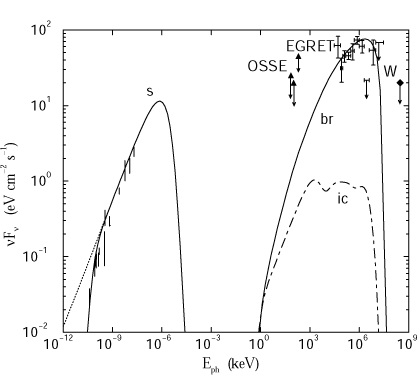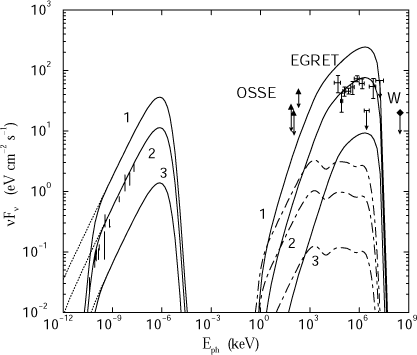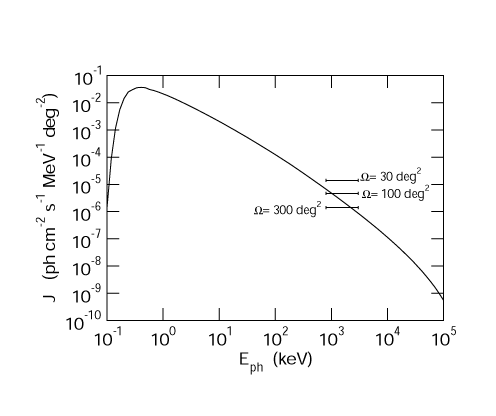High
Energy Astronomy: Particle Acceleration and Nonthermal Emission.
For many centuries astronomers could only study objects visible by the naked eye.
The invention of a telescope in the seventeen century was really a great
achievement for the astronomy, as it has led to many wonderful discoveries
and to substantial changes in the conventional picture of the world.
The science and technology breakthrough achieved in the 20th century made a
new revolution in the astronomy. Now astronomy deals not only with
optical observations but with observations in very broad photon energy ranges
that lie far beyond the optical range as well. The best example here is radio
astronomy that is no older than
eighty years but now is as well developed as optical astronomy.
The possibility to bring telescopes into space out of the Earth atmosphere
made it possible to observe Universe in photon energy ranges
previously unavailable or hardly
available from Earth, such as infrared, ultraviolet,
x-rays and gamma-rays. This expansion of the observable energy
range dramatically increased the quality and quantity of the
obtained data. In the last decades
x-ray and gamma-ray astronomy draws the closest attention of
of the scientific society. The reason is that
space-based telescopes together with the great progress
in high energy detectors technology made a breakthrough
in observable energy range as well as in angular and energy
spectral resolution.
All recent multiwavelength observations show that many astrophysical
objects have
nonthermal components in their spectra or even have totally nonthermal
spectra. The full list of the objects is very long
and includes supernova remnants (SNR),
high velocity clouds (HVC), gamma-ray bursts, barsters, masers and so on.
The processes
responsible for the nonthermal emission in all those objects could be absolutely
different. But the characteristics of their nonthermal radiation
give us very valuable information about the objects where it
originates from. So studying of nonthermal radiation
is a very useful method in researching many different astrophysical
objects.
As it was mentioned above, there are different mechanisms to generate nonthermal
emission. The following will be devoted to the nonthermal emission
produced by nonthermal particles, mostly by nonthermal electrons. This
generation mechanism has close links to the question about the origin
of Cosmic Rays (CRs) - a nonthermal particle flux (protons, electrons, nuclei)
observed in the neighborhood of the Earth. The reason is that the sources of the Cosmic
Rays must be the sources of nonthermal emission and likewise, some
sources of nonthermal emission are plausible candidates to be
Cosmic Ray sources as well.
Nonthermal particles can generate nonthermal radiation by different
radiation processes: synchrotron radiation in a magnetic field,
inverse Compton scattering, bremsstrahlung
radiation, secondary p0
decay. The secondary
p0 decay occurs during high energy nuclei
interaction with the interstellar medium and this is an emission process that is
possible only for nuclei (mostly for protons because of their higher
concentration). All other processes
are more effective for electrons because their mass is much lower then the
proton
mass. Positrons can also add to this emission
but usually positron concentration and fluxes are much smaller
then the electron ones, so the addition can be neglected.
If we want to calculate emission by any of the described processes
we need to know
the nonthermal particle spectrum in the radiation source.
And here we see a big difference between a nonthermal distribution function
and the equilibrium Maxwell
particle distribution function which is described
only by temperature and concentration. A nonthermal spectrum
characterizes a nonequilibrium state and depends not only on the parameters of the
initial equilibrium state but also on the way of its evolution.
The evolution depends on the mechanism of particle acceleration and
energy losses. Thus, in order to calculate a particle distribution function
it is necessary to know
the acceleration mechanisms. That is why investigations of the mechanisms
of particle acceleration in astrophysical conditions have a lot of
practical implications in astrophysics.
There are different ways to accelerate particles.
We will shortly describe the only one of them - particle acceleration on
shock fronts also named "first order Fermi acceleration". Let us consider an
extended object with a high energy release. In this case usually at least few
shock waves are formed. We will focus on the SNRs, HVCs, and shocks in the
interplanetary medium. In the case of SNRs the initial energy release is
produced by a supernova explosion, in the case of HVCs an energy emission is
produced by the interaction of the clouds with gas in the Galaxy halo and in the
Solar wind shocks energy is supplied by the energetic processes on the Sun.
As was shown in [1,2] shock waves are an effective particle
accelerator due to the first order Fermi [3] mechanism.
Particles that are crossing
the shock front from upstream to downstream and reverse
in average are gaining
energy in these cycles. It should be mentioned here that in
the astrophysical conditions a medium density is very low so the
mean free path due to Coulomb interactions is much shorter than a mean
free path due to diffusion on electro-magnetic field fluctuations.
The structure of these collisionless shock waves is different from
the structure of the usual
hydrodynamic shocks and it was studied
by several authors [4,5] that used the so called "hybrid code" numerical
simulation method. In this method electrons are treated as a fluid while
proton trajectories are calculated numerically by solving
their dynamical equations.
It was shown that the structure of a quasi-parallel
(magnetic field vector is almost parallel to the shock front normal)
and quasi-perpendicular (magnetic field vector is almost parallel to the shock
front plain) shock waves is different. Below we will consider only the case of
the quasi-parallel shocks. These shock waves have an extended shock front
with a characteristic width of a few hundred ion plasma lengths.
In this region ("transition region") strong magnetic
field fluctuations are formed. The magnitude of the magnetic field in
these fluctuations could be much higher than the mean magnetic
field values in upstream and downstream plasma flows. A particle with a mean free
path that is greater than the width of the transition region is effectively
injected in the Fermi mechanism. For typical astrophysical conditions it
is true for protons with an energy only slightly higher than the thermal energy.
It could be thought that protons acceleration by Fermi mechanism may be considered
in this test particle approximation, but this is not right. There is a strong
nonlinear interaction between protons and electro-magnetic fluctuations in
the transition region. These fluctuations are formed by Alfven waves that are
generated by plasma instabilities induced by proton flows.
Protons themselves scatter very effectively on
these fluctuations. This nonlinear problem has not been solved analytically and only
numerical modeling by hybrid codes is now feasible [4,5]. And there is even more
complication here. Accelerated high energy particles in the upstream zone
produce an additional pressure to the thermal plasma pressure.
This pressure makes an additional deceleration of the incoming plasma
in the upstream region. All this leads to creation of the shock precursor -
a smooth decrease of plasma velocity (and increase of density) in the
upstream flow with the characteristic length a few orders higher than the width
of the transition region. This length depends on the upstream diffusion
coefficient and flow velocity. The formation of the shock precursor
was studied in [6,7].
The usual way to study it is to solve a system of hydrodynamic
equations taking into account the additional pressure
from high energy accelerated particles. It looks like that a precursor is
formed only in strong shocks (shocks with high Mach number).
If a shock is strong enough then
its structure is defined by proton kinetic instabilities. Such
shocks are called supercritical. In this case we
can consider electrons as test particles because of their
much lower mass. But again, because of their lower mass, the mean free
path of the thermal electrons is much shorter than either
thermal proton mean free path and the width of the transition
region. So electrons are not directly involved in the Fermi
acceleration mechanism, and here appears a question about a mechanism
of electrons preacceleration up to the energies from which they are
effectively involved into the Fermi acceleration mechanism, or by other
words, a question of an injection
mechanism.
Different injection mechanisms are possible. Levinson [8] suggested
a mechanism of injection by whistlers for the case of very strong
shocks with Mach number
M>M*=sqrt(4pP/B2Mp/Me) and anisotropic
electron distribution function. We [9] suggested and considered the injection
mechanism due to electron scattering on the magnetic field fluctuations in the
transition region. This is an appropriate injection for shocks with Mach
numbers 1<M<M*. The electron distribution function in this
case could be considered isotropic with a good accuracy, and diffusion
approximation is appropriate. Below there is a short description of our
model that is presented in detail in [9].
In our model we use a shock wave structure obtained in [5]. We find
electron distribution function as a numerical solution of a kinetic
equation describing convection, diffusion in coordinate and momentum
spaces and energy losses. We solve this equation in the upstream and downstream
plasma flows and in the
transition region with conditions of continuous distribution
function and flux together with appropriate boundary conditions on
the system borders. We as well obtain the electron
distribution function taking into account injection
process, Fermi mechanism and energy looses. In our model injection
occurs due to second order Fermi acceleration in the transition region
where electrons scatter on magnetic field fluctuations co-moving with
the plasma flow and it is described as diffusion
in the momentum space.
We used our model for calculation of the electron energy spectrum in the vicinity
of shocks in the interplanetary medium, supernova remnants (SNR),
regions of interaction of high velocity clouds (HVC) with the Galactic halo.
The results of modeling of the electron spectrum in the interplanetary medium
are discussed in [9]. This is a very interesting application itself because
spacecraft measurements could directly test our model predictions as well
as the theory describing the structure of collisionless shock waves.
Below we will concentrate on applications to SNRs and HVCs. In these cases
we not only obtain the electron spectrum but also use it for calculation
of the emission from these objects due to synchrotron, bremsstrahlung
and inverse Compton radiation processes.
The question about the origin of the high energy radiation from SNRs is broadly
discussed in the literature.
High energy radiation is often interpreted as synchrotron emission.
This interpretation was suggested in [11] for SN1006. Another possible
interpretation was suggested by Asvarov et. al. in [12] who interpreted
the high energy emission as nonthermal bremsstrahlung radiation.
We applied our model to the modeling of the SNR IC443 [10]. This is a
shell structure SNR that was repeatedly observed in different spectral ranges
including optical, radio, x-ray and gamma-ray bands.
This remnant is a very interesting
object. The molecular lines emission registered from the shell
of this SNR shows that it is interacting with high density molecular clouds.
We calculated the total emission from the IC443 due to synchrotron,
bremsstrahlung and inverse Compton radiation using our model of the electron
injection and acceleration
to obtain the electron energy spectrum [10].

In figure 1
one can see
the calculated fluxes measured on Earth for the case of injection from
the thermal initial upstream spectrum in comparison with the experimental data.
The experimental points were taken from papers [15] (radio), [16] (OSSE, EGRET),
[17] (WHIPPLE). For synchrotron radiation free-free absorption was
taken into account.

Figure 2 is similar but shows fluxes calculated
in assumption that the initial upstream spectrum was a spectrum of the CR
electrons. The CR spectrum becomes flatter on low energies. To take
this into account we suggested a plateau in the initial CR electron
distribution function
normalized by p2dp on low energies up to an energy Ec.
The curves 1, 2, 3 were calculated for Ec equal to 3 MeV, 8 MeV, 50 MeV.
It is necessary to mention that the whole spectrum of the IC443 could be thus explained
by leptonic emission only. And it is impossible to conclude if an addition
from secondary pion decay is present in the observable spectrum. Thus,
a direct confirmation of an effective proton acceleration in the
SNR IC443 cannot be done yet. This confirmation could be very important
for the theory that considers SNR remnants as the sources of cosmic rays.
One more very interesting application for our model is prediction and
explanation of the nonthermal radiation from high velocity clouds.
These clouds were first observed by the emission of neutral hydrogen
as gas clouds falling on the Galaxy plain with the
velocities of about 100-150 km/s. This velocity differs from the
velocity of the Galaxy
gas flow. The distance to these objects is not yet well defined,
but there are some estimations [13] giving the distance of a few kpc.
So it looks like these clouds are the clouds of hydrogen
with masses near 105 Solar masses that are really falling
onto the Galaxy plain.
If we use Galactic halo temperature and density values we find that
these clouds should produce shock
waves with Mach numbers M around 3 while interacting with Galactic halo.
These shocks are relatively weak but,
nevertheless, they could be particle accelerators. In [14] we calculated
the flux of the high energy radiation from an ensemble of these clouds. The
excess of the nonthermal flux in a few MeV energy range was observed
by COMPTEL [14].

In
figure 3 the radiation flux from the HVC ensemble calculated according to our
model is shown together with COMPTEL data points for different assumptions
about total angular size of the ensemble. There is a good consistency of our
predictions with COMPTEL observations.
The presented results show that our model based on very simple
physical principles is able to describe the process of electron acceleration
in various extended astrophysical objects. The new generation of high energy
telescopes with better spatial and energy resolution in the nearest
future will supply much more observational data which will help us to make an
advance in our understanding of physics of the extended nonthermal radiation
sources and will provide more opportunities for testing of our model.
1. G.F. Krymskii, Sov. Phys. Dokl., 22, 327 (1977).
2. A.R. Bell, MNRAS, 182, 147 (1978).
3. E. Fermi, Phys. Rev., 75, 1169 (1949).
4. K.B. Quest, J. Geoph. Res., 93, 9649 (1988).
5. L. Bennett, D.C. Ellison, J. Geoph. Res., A 100, 3439 (1988).
6. R. Blandford, E. Eichler, Phys. Rep., 154, 2 (1987).
7. F.C. Jones, D.C. Ellison, Space Sci. Rev., 58, 259 (1991).
8. A. Levinson, Astroph. J., 401, 73 (1992); 426, 327 (1994).
9. A.M. Bykov, Y.A. Uvarov, JETP 88, 3 (1999).
10.A.M. Bykov, R.A. Chevalier, D.C. Ellison, Yu.A. Uvarov, Astroph. J., 538, 203 (2000).
11.D.C.Ellison, F.C. Jones, S.P. Reynolds, Astroph. J., 360, 702 (1990).
12.A.I.Asvarov, V.A. Dogiel, O.H. Guseinov, F.K. Kasimov, Astron. Astroph.,
229, 196 (1990).
13.L. Danly, C.E. Albert, K.D. Kuntz, Astroph. J., 416, L29 (1993).
14.J.J Blom, H. Bloemen, A.M. Bykov, W.B. Burton, Dap Hartmann, W. Hermsen, A.F. Iyudin, J. Ryan, V. Schonfelder, Yu.A. Uvarov, Astron. Astroph., 321, 288 (1997).
15.W.C.Erickson,M.J.Mahoney, Astroph. J., 290, 596 (1985).
16.S.J.Sturner,J.G.Skibo,C.D.Dermer et al., Astroph. J., 490, 619 (1997).
17.R.W.Lessard et al., 24th Int. Cosmic Ray Conf. (Rome), 2, 475 (1995).
[Top of this page] [Department
of Theoretical Astrophysics]
This site is supported by the RFBR grant No. 00-07-90200
Page last updated on January 15, 2005 by Yury
Uvarov


